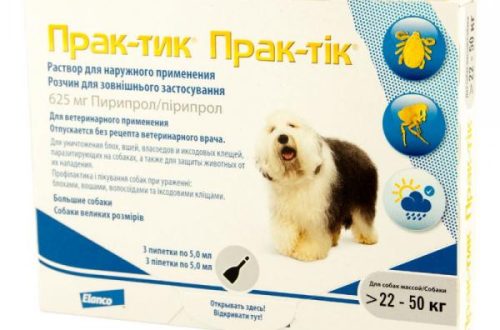
Distemper in dogs

As a rule, after a disease, dogs develop lifelong immunity, but there are also cases of secondary infection.
Before the widespread use of vaccination against distemper (the first vaccines for dogs were invented in the 60s of the last century), the disease was very common in dogs. At present, the disease is rarely registered, but due to the mutation of the virus (there are currently more than 8 different genotypes of the virus!) And the obsolescence of the vaccine, cases of the disease are again becoming more frequent. Among wild animals, the disease is still widespread. In addition to dogs, foxes, ferrets, wild dogs, jackals, coyotes, lions, tigers, cheetahs, leopards, seals, sea lions and dolphins can get plague.

Contents
Symptoms of distemper in dogs
As a rule, distemper in dogs is manifested by an intermittent fever characteristic of this disease (this is a condition when the temperature rises sharply, then drops sharply to a normal value, then rises again) with disruption of various body systems. Depending on the genotype of the virus, the state of immunity, conditions of detention and other factors, distemper in dogs can manifest itself in a variety of ways: there are symptoms of respiratory, skin, disorders of the gastrointestinal tract, neurological and caused by secondary contamination of bacterial microflora (pneumonia). In more detail, we will consider each group of symptoms for distemper in dogs in the table:
Group of symptoms | Manifestations |
Respiratory | Fever; Bilateral discharge from the nose and eyes; Cough. |
Gastrointestinal | Vomiting; Diarrhea; Signs of dehydration. |
Dermatological | Finger and nasal hyperkeratosis; Pustular dermatitis. |
Ophthalmic | Uveitis; Keratoconjunctivitis; Keratitis and optic neuritis; Blindness. |
Neurological | Vocalization; Convulsions; behavioral disorders; Manege movements; visual disturbances; vestibular symptoms; Cerebellar disorders; And others. |
It should be noted that a sick dog may have one of the listed symptoms, or many.
Common signs of the presence of distemper in a dog include a rise in body temperature. Moreover, the first rise in temperature, starting 3-6 days after the disease, may go unnoticed. The first symptoms usually appear by the second rise in temperature. It usually begins a few days after the first and is accompanied by symptoms characteristic of distemper: the dog develops discharge from the eyes and nose, refusal to eat follows, and general lethargy is observed. Further, with the development of the disease, symptoms of damage to the gastrointestinal tract and/or the respiratory system are already added, which are aggravated in the case of the addition of secondary microflora. It is also common (in about a third of affected dogs) to develop neurological symptoms. In the chronic course of the disease, symptoms of damage to the nervous system may appear only 2-3 months after the onset of the disease. Sometimes dogs can hide from the light.
Possible Causes of Distemper in Dogs
The cause of distemper is the ingestion of a virus of the Paramyxoviridae family into the body. Only unvaccinated animals get sick.
The virus in the environment is quickly destroyed and lives no more than a day. A healthy dog can become infected from a sick dog by airborne droplets (through secretions, feces). The widespread vaccination of pets has significantly reduced the incidence of this disease, but due to the mutation of the virus and the formation of new genotypes that are not affected by the vaccine, the disease is becoming relevant again.
The main reason for the spread of the disease is that an infectious dog begins to shed the virus into the environment even before the onset of clinical symptoms (on the fifth day after the virus enters the body). Also, the isolation of the virus can last up to 3-4 months after the onset of the disease.
Forms and types of distemper
Depending on the severity of the symptoms of distemper, the following forms of the disease are distinguished: pulmonary, intestinal, skin, nervous, mixed. However, it is worth noting that this division is conditional and the intensity of the manifestation of symptoms depends on each specific case.
There are also acute and chronic types of the course of the disease. Some authors also distinguish hyperacute and subacute types. The hyperacute form, which is the most dangerous, is characterized by a sharp rise in temperature to 40-41 degrees, the dog is very depressed, refuses to eat, falls into a coma and dies on the second or third day after the onset of the disease. The acute and subacute forms of distemper in dogs last an average of 2-4 weeks and are characterized by a wide variety of signs and symptoms that we have described above. In the chronic type of the disease, which can last several months, sluggishly progressive neurological, skin, and ophthalmological disorders are usually noted.
In general, the outcome of the disease depends on the genotype of the virus and the immune response of the dog. According to statistics, about 50% of affected dogs die within 2 weeks to 3 months after infection. Puppies have a much higher mortality rate than adult dogs. It is worth noting that in other species of carnivores, mortality can reach 100%.

Diagnostics
Distemper should be distinguished from diseases with similar symptoms, such as kennel cough (similar respiratory symptoms are observed), parvovirus and coronavirus enteritis (similar gastrointestinal disorders), from bacterial and protozoal (for example, giardiasis) diseases. With the severity of neurological disorders, the disease must be distinguished from granulomatous meningoencephalomyelitis, protozoal encephalitis, cryptococcosis, and also from heavy metal poisoning.
How can you find out if your dog is sick? Diagnosis of this disease is rather difficult and should be complex. According to the general blood test at an early stage, a decrease in the number of lymphocytes is determined. A chest x-ray is done if pneumonia is suspected.
In the presence of neurological symptoms, an MRI is usually performed – in this disease, changes in the brain, as a rule, are not detected or are not specific.
A study of the cerebrospinal fluid is also carried out, in which a high content of cells, protein, antibodies to the virus and viral agents is found.
Serological examination is considered the main method of diagnosis, but it is also difficult. In the acute stage of the disease, antibodies may be absent, and a false positive result may also occur after vaccination. For research, swabs from the conjunctiva and blood are taken. Testing for antigens (ELISA and ICA) has higher sensitivity and specificity, but there may also be false positive results after vaccination.
Summary data on the results of various diagnostic studies are given in the table:
Analysis | Result |
General blood analysis | Lymphopenia Regenerative anemia Thrombocytopenia |
Biochemistry | hypokalemia Hyponatremia Hypoalbuminemia |
Cerebrospinal fluid analysis | Protein Boost Pleocytosis – that is, an increased number of cellular elements |
Urinalysis | No specific changes |
X-ray | Changes characteristic of pneumonia |
MRI | Nonspecific changes characteristic of meningoencephalitis Also, with obvious neurological symptoms, there may be no changes on MRI. |
Test for antibodies | IgM will be high within three months after infection, high sensitivity during acute infection and less during the chronic stage (60%); IgG may be elevated during past infection, during the acute stage, and as a result of vaccination |
Test for antigens | Relatively high sensitivity and specificity |
Treatment for distemper in dogs
How to treat distemper in dogs?
To begin with, all dogs that have the first signs of distemper must be isolated from other animals.
Animals with mild symptoms may recover on their own and will not require treatment. Animals with more severe symptoms require hospital treatment.
Acute neurological symptoms are usually progressive and such animals have a poor prognosis. It is possible to cure a dog with disorders of the nervous system only in a clinic.
Unfortunately, there is no specific treatment for distemper in dogs. All treatment is symptomatic therapy.
Antibiotics are indicated to prevent the development of secondary microflora.
Phenobarbital preparations are used as anticonvulsant therapy for convulsions. Also, in some cases, a drug such as gabapentin has a good effect.

Distemper in puppies
In most cases, puppies are affected by this disease. If the disease has been transferred in the neonatal period (that is, at the age of up to 14 days), there may be serious damage to the enamel and roots of the teeth. Unvaccinated puppies have a very high mortality rate.
Symptoms of distemper in a puppy usually appear very quickly. The first signs of distemper in a puppy include refusal to eat. This is usually followed by discharge from the nose and eyes.
If a puppy is suspected of distemper, it is necessary to immediately take it to the clinic! This disease can be treated only in a hospital setting.
Prevention of distemper in dogs
What to do so that the dog does not get sick? In the first place, infection must be prevented through vaccination. For the specific prevention of canine distemper, there are modern vaccines. Immunity to the disease after the introduction of vaccines is observed from the third day.
In order not to think about how to treat distemper in a dog, it is necessary to fully comply with the vaccination schedule. The first vaccination at 6-8 weeks, the last at 16, revaccination of adult animals is carried out 1 time in 3 years.
It is important to note that the puppy is born with maternal immunity, which protects the puppy from disease until 6-8 weeks of age, in some cases up to 14 days. That is why vaccination before the puppy reaches two months is usually not advisable. Moreover, while maternal immunity is in effect, the vaccine simply will not work, which is why it is recommended to re-vaccinate until the puppy reaches the age of 16 months.
In order to prevent the spread of distemper in dogs, it is necessary to vaccinate the entire population of dogs.
When importing new dogs with unknown immune status, they must be kept in isolation in quarantine for 21 days.
Where can a dog get infected?
The disease is transmitted by airborne droplets. The virus enters the mucous membrane of the respiratory tract and spreads to the lymph nodes of the body, then within a week it spreads throughout the lymphatic system. Further development of the virus depends on the dog’s immunity – with a good immune response, the virus can be destroyed, and the disease will be asymptomatic. With weak immunity, the virus from the lymphatic system is transferred to other body systems (digestive, respiratory, central nervous system) and causes signs of the disease.
Usually, a dog can become infected through contact with wild animals and sick dogs. The incubation period of canine distemper is 3-7 days, although under certain conditions it can reach several months.
Humans can also carry the virus, and even rodents, birds and insects. It is possible to transmit the virus through various objects contaminated with the virus.
Transmission of distemper to humans and animals
Canine distemper virus belongs to the same family of paramyxoviruses as the causative agent of measles in humans. Therefore, it is believed that theoretically the plague virus can be transmitted to humans, but the disease is asymptomatic. However, it is worth noting that most people are vaccinated with the measles vaccine as a child, which provides complete protection against the canine distemper virus. Therefore, in general, we can conclude that distemper in dogs is not transmitted to humans.
Dog distemper is dangerous for other animals. Not only dogs can get sick, but also other animals that are susceptible to the disease (we listed them above – these are foxes, jackals, large wild cats and even dolphins).

Possible complications
The main complications of distemper in a dog include disorders of the central nervous system, which can manifest themselves in various disorders.
If a puppy has been ill in the neonatal period (that is, before reaching the age of 14 days), the puppy may experience a serious consequence in the form of damage to the enamel and roots of the teeth. Older dogs may show characteristic enamel hypoplasia.
In the chronic course of distemper in dogs, complications such as visual impairment up to blindness are possible.
Also, against the background of suppression of immunity in distemper, dogs may develop an exacerbation of latent diseases, for example, kennel cough in dogs.
At the end of this article, I would like to conclude that only competent and timely vaccination can protect the dog from the disease. If symptoms of distemper appear in a dog, it is necessary to deliver it to the clinic as soon as possible and start treatment!
The article is not a call to action!
For a more detailed study of the problem, we recommend contacting a specialist.
Ask the vet
December 9 2020
Updated: February 13, 2021





